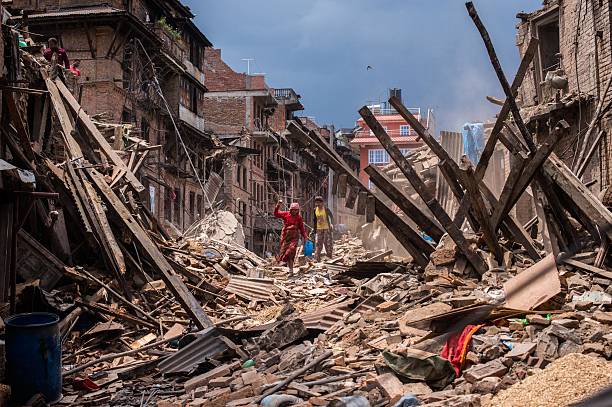Nepal, a landlocked country in South Asia, sits at the intersection of two massive tectonic plates: the Indian Plate and the Eurasian Plate.
This geological setting makes Nepal one of the most seismically active countries in the world, prone to frequent and sometimes devastating earthquakes.
This comprehensive study examines the recent seismic events that have struck Nepal, their impacts, the country’s historical context of earthquakes, and the broader implications for disaster preparedness and resilience in the region.
Recent Earthquake Events
October 2, 2023 Earthquake
On October 2, 2023, Nepal was struck by a powerful earthquake that sent shockwaves across the region.
| Parameter | Value |
|---|---|
| Date | October 2, 2023 |
| Magnitude | 7.2 (Mw) |
| Epicenter | Near the border with China, about 150 km northeast of Kathmandu |
| Affected areas | Nepal, India, China, Bangladesh, and Bhutan |
Impact and Aftermath
The earthquake’s impact was widespread and severe:
- Casualties: At least 300 people were killed.
- Geographical Reach: The quake was felt across Nepal, India, China, Bangladesh, and Bhutan.
- Aftershocks: Several aftershocks followed, some as strong as magnitude 6.
- Landslides and Avalanches: The earthquake triggered landslides and avalanches in the Himalayan region, blocking roads and hampering rescue efforts.
- Infrastructure Damage: Many buildings, including historical monuments and temples, collapsed or were damaged.
- Utility Disruption: Power supply and communication networks were disrupted in many areas.
- Humanitarian Crisis: The United Nations estimated that more than 5 million people were affected by the quake, with over 1 million in need of humanitarian assistance.
October 3, 2023 Earthquake Sequence
Just a day after the major quake, on October 3, 2023, Nepal experienced a series of four powerful earthquakes within the span of just one hour. This sequence of quakes further compounded the damage and chaos from the previous day’s event.
| Earthquake | Magnitude | Epicenter | Time |
|---|---|---|---|
| Main shock | 6.3 | Talkot area of Bajhang district, 700 km west of Kathmandu | Within 1 hour |
| Aftershock 1 | 4.9 | Near main shock | Within 15 minutes of main shock |
| Aftershock 2 | 4.8 | Near main shock | Within 15 minutes of main shock |
| Aftershock 3 | 4.5 | Near main shock | Within 15 minutes of main shock |
Impact of October 3 Sequence
The impact of this earthquake sequence was significant, especially in western Nepal:
- Casualties: At least 6 people were killed and 11 injured, according to the National Emergency Operation Centre (NEOC).
- Infrastructure Damage: Widespread damage occurred in the western districts of Bajhang, Baitadi, and Darchula. Many houses collapsed and roads cracked.
- Landslides and GLOFs: The earthquakes triggered landslides and glacial lake outburst floods (GLOFs) in the Himalayan region.
- Cross-border Impact: In Sikkim, India, a GLOF from the South Lhonak Lake near the Nepal-China border caused a flash flood in the Teesta river, sweeping away bridges, roads, and houses along its banks.
- Utility Disruption: The flood disrupted power supply and communication networks in Sikkim.
November 3, 2023 Earthquake
A month after the October events, another significant earthquake struck Nepal, this time affecting a different region of the country.
| Parameter | Value |
|---|---|
| Date | November 3, 2023 |
| Time | 23:47 local time (18:02 UTC) |
| Magnitude | 6.4 (Mw) |
| Depth | 10 km (6.2 miles) |
| Epicenter | 28.84°N 82.19°E |
| Location | Jajarkot district, Karnali Province, Nepal |
| Affected areas | Jajarkot and Rukum West districts |
Impact of November 3 Earthquake
The November earthquake, while not as large as the October 2 event, still caused significant damage:
- Casualties: 153 deaths were reported, with over 300 injuries.
- Infrastructure Damage:
- Over 8,000 homes were damaged or destroyed.
- Public buildings, including schools, health posts, and government offices, were affected.
- Several road sections were blocked due to landslides.
- Communication Disruption: Temporary disruption of communication networks occurred.
- Economic Impact:
- Direct losses were estimated at millions of dollars due to infrastructure damage.
- Indirect losses included disruption to local businesses, agriculture, and tourism.
- Long-term impact potentially included setbacks to regional development efforts.
Tectonic Setting and Geological Context
The frequent earthquakes in Nepal are a direct result of the ongoing collision between the Indian and Eurasian tectonic plates. This geological process is fundamental to understanding the seismic activity in the region.
Plate Tectonics
- The Indian plate is subducting under the Eurasian plate.
- These plates are moving towards each other at a rate of about 4 cm per year.
- This collision is responsible for the formation of the Himalayan mountain range.
- The movement creates immense stress and strain along the fault lines.
- When the accumulated stress exceeds the strength of the rocks, they rupture and release energy in the form of seismic waves, causing an earthquake.
Main Himalayan Thrust (MHT)
- Many of Nepal’s major earthquakes, including the recent ones, occur along the Main Himalayan Thrust (MHT).
- The MHT is a major fault line that runs along the southern edge of the Himalayas.
- Different segments of the MHT can rupture at different times, leading to earthquakes in various parts of Nepal and the surrounding region.
Comparison with 2015 Earthquake
The earthquakes in 2023 drew comparisons with the devastating quake of April 25, 2015:
- The 2015 earthquake killed nearly 9,000 people and injured more than 22,000 in Nepal.
- Both the 2015 quake and the recent ones occurred on the same fault segment (MHT).
- However, the 2023 quakes were generally deeper and in different locations along the fault line.
- This indicates that different parts of the MHT are breaking at different times, highlighting the ongoing seismic risks in the region.
Historical Context of Earthquakes in Nepal
Nepal’s history is punctuated by significant seismic events, with major earthquakes occurring roughly once per century. This historical perspective is crucial for understanding the long-term seismic risks in the region.
| Year | Magnitude | Notable Impact |
|---|---|---|
| 1255 | 7.8 | One-third of Kathmandu’s population killed, including the king |
| 1408 | 8.2 | Destroyed many temples and houses, large land crack formed |
| 1833 | 8.0 | 6,500 people killed, damaged Dharahara tower and Jagannath temple |
| 1934 | 8.1 | 10,700-12,000 people killed, most historical monuments in Kathmandu destroyed |
| 1980 | 6.5 | 200 people killed in Pithoragarh district |
| 1988 | 6.9 | 1,091 people killed, over 6,000 injured in eastern Nepal and northern India |
| 2011 | 6.9 | 111 people killed, over 600 injured in Sikkim and neighboring areas |
| 2015 | 7.8 | 8,857 people killed, millions displaced, massive destruction |
Key Historical Events
- 1255 A.D.: A 7.8 magnitude quake killed one-third of Kathmandu’s population, including the king. This event is one of the earliest recorded major earthquakes in Nepal’s history.
- 1408 A.D.: An 8.2 magnitude quake destroyed many temples and houses and caused a large crack in the land. This event demonstrates the potential for extreme magnitude events in the region.
- 1833 A.D.: An 8.0 magnitude quake killed 6,500 people and damaged many buildings, including the iconic Dharahara tower and the Jagannath temple. This earthquake highlighted the vulnerability of Nepal’s architectural heritage to seismic events.
- 1934 A.D.: Known as the Great Nepal-Bihar earthquake, this 8.1 magnitude event killed between 10,700 to 12,000 people and destroyed most of Kathmandu’s historical monuments. It remains one of the most devastating earthquakes in Nepal’s recorded history.
- 2015 A.D.: The most recent major earthquake before the 2023 events, this 7.8 magnitude quake and its aftershocks killed 8,857 people, displaced millions, and caused widespread destruction. It also triggered landslides and avalanches in the Himalayas, compounding the disaster.
This historical record underscores the recurring nature of major seismic events in Nepal and the ongoing risk faced by the country’s population and infrastructure.
Emergency Response and Challenges
The response to the recent earthquakes in Nepal involved both national and international efforts, facing numerous challenges due to the country’s unique geography and infrastructure limitations.
Government Actions
- State of Emergency: The government of Nepal declared a state of emergency following the major quakes.
- International Appeal: An appeal for international aid was made to cope with the aftermath of the quakes.
- Deployment of Resources:
- Nepal Army, Armed Police Force, and Nepal Police were deployed to affected areas.
- Helicopters were used for reaching remote locations.
- Medical Assistance: Mobile medical teams were dispatched to provide emergency care.
- Evacuation: Seriously injured individuals were airlifted to hospitals in Kathmandu.
International Support
The international community responded swiftly to Nepal’s call for assistance:
- UN Coordination: The United Nations coordinated the humanitarian response and launched a flash appeal for $150 million to provide life-saving assistance to the affected people.
- World Bank Support: The World Bank announced a $500 million package to support Nepal’s recovery and reconstruction efforts.
- Country-specific Aid:
- India: Provided emergency supplies, medical teams, and financial aid.
- China: Sent search and rescue teams and medical supplies.
- United States: Offered financial assistance for relief and reconstruction.
- NGO Involvement: Various international NGOs mobilized resources and personnel to assist in relief efforts.
Challenges Faced
Several factors complicated the relief efforts:
- Remote Terrain: Many affected areas were in mountainous regions with limited accessibility, making it difficult for rescue teams to reach victims quickly.
- Weather Conditions: Cold temperatures and occasional rainfall hampered rescue operations and made life difficult for displaced persons.
- Resource Constraints: There was limited availability of heavy equipment for debris removal in remote areas.
- Infrastructure Damage: Damaged roads and bridges made it challenging to transport aid and rescue personnel.
- Communication Disruption: Breakdown of communication networks hampered coordination of relief efforts.
- Aftershocks: Continuing aftershocks posed risks to rescue workers and survivors, and caused further damage to weakened structures.
Long-Term Recovery and Future Preparedness
The recent earthquakes have highlighted the need for comprehensive long-term recovery plans and enhanced preparedness measures in Nepal.
Government Initiatives
The Nepalese government has announced several measures for long-term recovery:
- Housing Reconstruction:
- Plans to provide financial assistance for rebuilding homes.
- Focus on promoting earthquake-resistant construction techniques.
- Infrastructure Rehabilitation:
- Prioritization of critical infrastructure such as schools and health facilities.
- Improvement of road networks to enhance accessibility in remote areas.
- Economic Support:
- Consideration of tax relief and low-interest loans for affected businesses.
- Programs to revitalize local economies, including agriculture and tourism sectors.
Disaster Risk Reduction (DRR) and Climate Change Adaptation (CCA)
The earthquakes have raised awareness about the importance of Disaster Risk Reduction (DRR) and Climate Change Adaptation (CCA) in Nepal:
- DRR: Refers to the policies and practices that aim to prevent or reduce the impact of disasters on people and assets.
- CCA: Refers to the actions that aim to reduce the vulnerability of people and systems to the effects of climate change.
Both DRR and CCA are essential for enhancing Nepal’s resilience and sustainability in the face of multiple shocks and stresses.
Key Focus Areas for Future Preparedness
- Building Codes and Infrastructure:
- Strengthening and strict enforcement of building codes, especially in high-risk areas.
- Seismic retrofitting of existing critical structures.
- Early Warning Systems:
- Investment in advanced seismic monitoring and early warning systems to help minimize casualties.
- Development of robust emergency communication systems resistant to network disruptions.
- Community Preparedness:
- Implementation of regular drills and awareness programs to improve community resilience and response during earthquakes.
- Comprehensive earthquake preparedness programs in schools and communities.
- Healthcare System Enhancement:
- Improving emergency medical response capabilities, including in remote areas.
- Ensuring hospitals and health centers are earthquake-resistant and well-equipped to handle mass casualties.
- Land Use Planning:
- Implementing stricter regulations on construction in high-risk areas.
- Developing strategies for safer urban expansion and rural development.
- Research and Monitoring:
- Continued geological and seismological research to better understand earthquake risks.
- Regular monitoring and assessment of glacial lakes to mitigate GLOF risks.
- Cross-border Cooperation:
- Enhancing regional cooperation for disaster response and information sharing, given the cross-border impacts of major earthquakes.
Conclusion
The recent earthquakes in Nepal serve as stark reminders of the country’s vulnerability to seismic events. While immediate response efforts have shown improvements since previous disasters, these events underscore the ongoing need for comprehensive disaster risk reduction strategies.
Nepal faces multiple challenges in its quest for seismic resilience. Its unique geography, featuring remote and mountainous terrain, complicates rescue and relief efforts. The country’s position at the intersection of tectonic plates means that earthquakes will continue to be a recurring threat. Additionally, Nepal grapples with developmental challenges, including poverty, inequality, and political instability, which exacerbate its vulnerability to natural disasters.
However, these recent earthquakes also present an opportunity for Nepal to further strengthen its disaster preparedness and response mechanisms. By learning from these experiences and implementing forward-looking policies and practices, Nepal can enhance its resilience to future earthquakes and minimize their impact on lives and livelihoods.
Key areas for focus include:
- Continued improvement of building practices and infrastructure resilience.
- Enhanced early warning systems and community preparedness.
- Strengthened healthcare and emergency response capabilities.
- Integrated approaches to disaster risk reduction and climate change adaptation.
- Regional cooperation for disaster management.
As Nepal moves forward, it is crucial that these efforts involve all stakeholders – from government agencies and international partners to local communities. Only through collective action and sustained commitment can Nepal hope to build a more resilient future in the face of its seismic challenges.
The story of Nepal’s earthquakes is not just one of destruction and loss, but also of resilience, learning, and gradual progress towards a safer future. Each seismic event brings new lessons and spurs further improvements in preparedness and response. As the country continues to face this persistent natural threat, the hope is that each successive earthquake finds Nepal better prepared and more resilient than the last.



